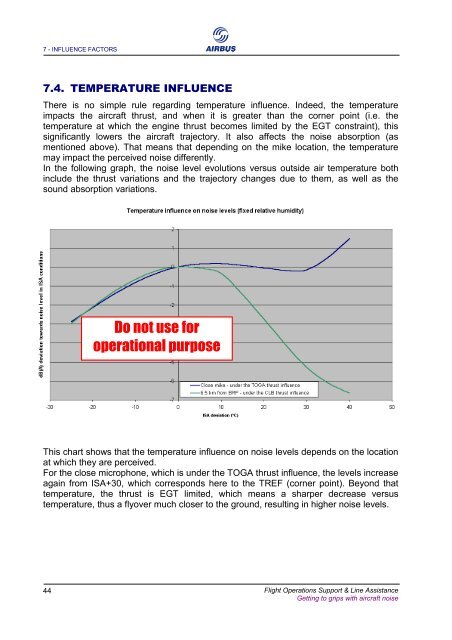Getting to Grips with Aircraft Noise
Getting to Grips with Aircraft Noise
Getting to Grips with Aircraft Noise
Create successful ePaper yourself
Turn your PDF publications into a flip-book with our unique Google optimized e-Paper software.
7 - INFLUENCE FACTORS<br />
7.4. TEMPERATURE INFLUENCE<br />
There is no simple rule regarding temperature influence. Indeed, the temperature<br />
impacts the aircraft thrust, and when it is greater than the corner point (i.e. the<br />
temperature at which the engine thrust becomes limited by the EGT constraint), this<br />
significantly lowers the aircraft trajec<strong>to</strong>ry. It also affects the noise absorption (as<br />
mentioned above). That means that depending on the mike location, the temperature<br />
may impact the perceived noise differently.<br />
In the following graph, the noise level evolutions versus outside air temperature both<br />
include the thrust variations and the trajec<strong>to</strong>ry changes due <strong>to</strong> them, as well as the<br />
sound absorption variations.<br />
44<br />
Do not use for<br />
operational purpose<br />
This chart shows that the temperature influence on noise levels depends on the location<br />
at which they are perceived.<br />
For the close microphone, which is under the TOGA thrust influence, the levels increase<br />
again from ISA+30, which corresponds here <strong>to</strong> the TREF (corner point). Beyond that<br />
temperature, the thrust is EGT limited, which means a sharper decrease versus<br />
temperature, thus a flyover much closer <strong>to</strong> the ground, resulting in higher noise levels.<br />
Flight Operations Support & Line Assistance<br />
<strong>Getting</strong> <strong>to</strong> grips <strong>with</strong> aircraft noise


